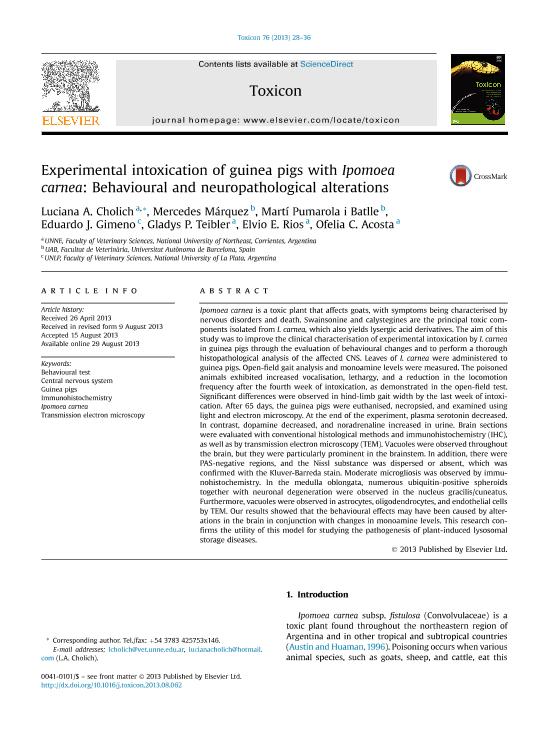Mostrar el registro sencillo del ítem
dc.contributor.author
Cholich, Luciana Andrea

dc.contributor.author
Marquez, Mercedes
dc.contributor.author
Pumarola i Batlle, Martí
dc.contributor.author
Gimeno, Eduardo Juan

dc.contributor.author
Teibler, Gladys Pamela

dc.contributor.author
Rios, Elvio E.
dc.contributor.author
Acosta, Ofelia Cristina

dc.date.available
2017-11-03T19:11:49Z
dc.date.issued
2013-08-29
dc.identifier.citation
Cholich, Luciana Andrea; Marquez, Mercedes; Pumarola i Batlle, Martí; Gimeno, Eduardo Juan; Teibler, Gladys Pamela; et al.; Experimental intoxication of guinea pigs with Ipomoea carnea: Behavioural and neuropathological alterations; Elsevier Academic Press Inc; Toxicon; 76; 29-8-2013; 28-36
dc.identifier.issn
0041-0101
dc.identifier.uri
http://hdl.handle.net/11336/27592
dc.description.abstract
Ipomoea carnea is a toxic plant that affects goats, with symptoms being characterised by nervous disorders and death. Swainsonine and calystegines are the principal toxic components isolated from I. carnea, which also yields lysergic acid derivatives. The aim of this study was to improve the clinical characterisation of experimental intoxication by I. carnea in guinea pigs through the evaluation of behavioural changes and to perform a thorough histopathological analysis of the affected CNS. Leaves of I. carnea were administered to guinea pigs. Open-field gait analysis and monoamine levels were measured. The poisoned animals exhibited increased vocalisation, lethargy, and a reduction in the locomotion frequency after the fourth week of intoxication, as demonstrated in the open-field test. Significant differences were observed in hind-limb gait width by the last week of intoxication. After 65 days, the guinea pigs were euthanised, necropsied, and examined using light and electron microscopy. At the end of the experiment, plasma serotonin decreased. In contrast, dopamine decreased, and noradrenaline increased in urine. Brain sections were evaluated with conventional histological methods and immunohistochemistry (IHC), as well as by transmission electron microscopy (TEM). Vacuoles were observed throughout the brain, but they were particularly prominent in the brainstem. In addition, there were PAS-negative regions, and the Nissl substance was dispersed or absent, which was confirmed with the Kluver-Barreda stain. Moderate microgliosis was observed by immunohistochemistry. In the medulla oblongata, numerous ubiquitin-positive spheroids together with neuronal degeneration were observed in the nucleus gracilis/cuneatus. Furthermore, vacuoles were observed in astrocytes, oligodendrocytes, and endothelial cells by TEM. Our results showed that the behavioural effects may have been caused by alterations in the brain in conjunction with changes in monoamine levels. This research confirms the utility of this model for studying the pathogenesis of plant-induced lysosomal storage diseases.
dc.format
application/pdf
dc.language.iso
eng
dc.publisher
Elsevier Academic Press Inc

dc.rights
info:eu-repo/semantics/openAccess
dc.rights.uri
https://creativecommons.org/licenses/by-nc-sa/2.5/ar/
dc.subject
Behavioural Test
dc.subject
Central Nervous System
dc.subject
Guinea Pig
dc.subject
Immunohistochemistry
dc.subject
Ipomoea Carnea
dc.subject
Transmission Electron Microscopy
dc.title
Experimental intoxication of guinea pigs with Ipomoea carnea: Behavioural and neuropathological alterations
dc.type
info:eu-repo/semantics/article
dc.type
info:ar-repo/semantics/artículo
dc.type
info:eu-repo/semantics/publishedVersion
dc.date.updated
2017-10-12T21:20:46Z
dc.identifier.eissn
1879-3150
dc.journal.volume
76
dc.journal.pagination
28-36
dc.journal.pais
Países Bajos

dc.journal.ciudad
Amsterdam
dc.description.fil
Fil: Cholich, Luciana Andrea. Universidad Nacional del Nordeste. Facultad de Cs.veterinarias. Departamento de Clinica. Cátedra de Farmacología; Argentina. Consejo Nacional de Investigaciones Científicas y Técnicas; Argentina
dc.description.fil
Fil: Marquez, Mercedes. Universidad Autonoma de Barcelona. Facultad de Veterinaria; España
dc.description.fil
Fil: Pumarola i Batlle, Martí. Universidad Autonoma de Barcelona. Facultad de Veterinaria; España
dc.description.fil
Fil: Gimeno, Eduardo Juan. Universidad Nacional de La Plata; Argentina. Consejo Nacional de Investigaciones Científicas y Técnicas; Argentina
dc.description.fil
Fil: Teibler, Gladys Pamela. Universidad Nacional del Nordeste. Facultad de Cs.veterinarias. Departamento de Clinica. Cátedra de Farmacología; Argentina
dc.description.fil
Fil: Rios, Elvio E.. Universidad Nacional del Nordeste. Facultad de Ciencias Veterinarias; Argentina
dc.description.fil
Fil: Acosta, Ofelia Cristina. Universidad Nacional del Nordeste. Facultad de Cs.veterinarias. Departamento de Clinica. Cátedra de Farmacología; Argentina. Consejo Nacional de Investigaciones Científicas y Técnicas; Argentina
dc.journal.title
Toxicon

dc.relation.alternativeid
info:eu-repo/semantics/altIdentifier/url/http://www.sciencedirect.com/science/article/pii/S0041010113003462
dc.relation.alternativeid
info:eu-repo/semantics/altIdentifier/doi/https://doi.org/10.1016/j.toxicon.2013.08.062
Archivos asociados
